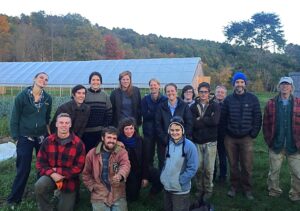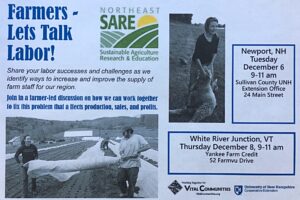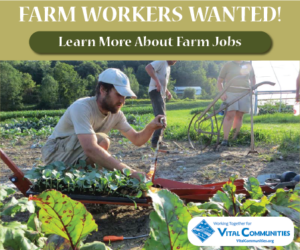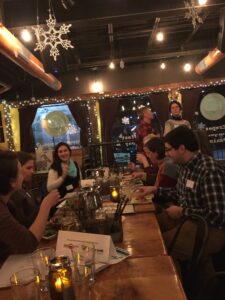Final report for ONE16-275
Project Information
Vital Communities’ Valley Food & Farm (VFF) program collaborated with area farmers to address the challenge of labor recruitment and retention in the Upper Valley of Vermont and New Hampshire. A working group of six farmers was established as an advisory group to guide the development of resources to aid in the hiring and retaining of labor through shared best practices, benchmarking, and the creation and beta-testing of a farm-focused job directory for the Upper Valley.
Two round table labor discussions were attended by 25 farmers to share labor challenges and solutions and to brainstorm innovative ideas for easing the labor challenge through improved hiring and management practices. Information was also gathered from farmers through 5 interviews, and an online survey completed by 14 farmers. We also surveyed 17 currently employed farm workers to get their perspective on what they were looking for in a job and what management practices would increase their interest in returning to a farm for more than one season. Most (80%) found their job online and 100% report that a living wage is important.
We found that farmers are interested in learning from each other and sharing best practices when given the opportunity. The round table discussions attracted many farmers and others that were clearly frustrated with the challenge of hiring, retaining, and managing labor. We found that farms that have good management practices (free food benefits, swim breaks, good training protocols, opportunities for advancement) tend to have higher staff retention rates. Hiring and training new staff is a significant expense that farms can reduce by improving management practices and increasing the retention rate. Many farmers reported that they recognized the potential savings and increased productivity that could be achieved by managing labor better, but either didn’t have the time or skills to implement these practices.
The information collected was shared on a farm labor resource page on the VFF website. The labor resource page also includes state and national labor resources, where to post job listings, and contact info for 20 potential sources of labor that were identified. The labor resource page had 198 page views in 2017.
Vital Communities created the Upper Valley Farm Job Directory in partnership with a local online community platform that already had an established presence with classified ads. The directory included educational information about what it's like to work on a farm along with farm descriptions, available positions, and farm contact information and was viewed 2354 times. Advertisements to promote the directory ran for 5 months. Twenty-eight farmers created 45 classified ads for the directory. There was no mechanism for tracking if any applications or hires resulted from the directory.
To close our project and celebrate our farmer partners we hosted a farmer celebration mixer to mark the completion of the project and to share the resources developed. Forty farmers attended.
Outreach to farmers occurred throughout this project to inform farmers as events happened or resources were available. Postcards were sent to 250 farmer for the round tables and the celebration mixer. Three emails went to 320 farms, service providers, and partners to let them know about the labor resources collected on the website and the job directory.
The questions we seek to answer include 1) What are regional barriers to and incentives for farmworker employment and retention? 2) How can farmers increase hiring and retention rates? 3) How can the region ensure that skilled workers find the Upper Valley a welcoming and preferable place of employment and opportunity? 4) What best practices should be promoted regionally for hiring, retaining, and managing a skilled workforce?
Cooperators
Research
2016
April-August: Compiled a record of existing online tools for finding farm labor. Results included all regional tools for farms to find labor and for labor to find farm jobs. We also identified national tools that appeared to be designed well and effective.
Solicited farmer participants for Farm Labor Working Group through SARE farmer partners, emails, Enews articles, and in person meetings with five farms. Working Group of six farmers was established to consult as project continued.
 2016 CRAFT Participant
2016 CRAFT Participant
Created a 16 question survey which was circulated to current farm labor (including workers, apprentices, and interns) through the regional CRAFT (Collaborative Regional Alliance for Farmer Training) participants, through Upper Valley farm contacts, farming discussion list, Facebook, and E-news. The survey questions were designed to learn how these farm workers found their current jobs and what they were looking for when searching for an agricultural job. Seventeen workers answered the survey questions. The results affirm many of the common assumptions such as the value of providing housing for farm labor and the importance of earning a livable wage. More than 80% of respondents found their job online and most said that farmers could improve on their communications around farm management and explanations of job expectations during the hiring process. Survey results:
September-December:
Created online survey for farmers to collect hiring and labor management information from area farms. Connected with Working Group over email to get feedback for farmer survey and for planning for farmer listening sessions.
Worked on developing proto-type for online farm job directory that would be part of the resources for farmers on the Vital Communities website. Webmaster tried various plug-ins and found programming incomapitibilities with the way the directory interacted with the website. We did provide a mock up of the new page to working group and included their feedback on design and content.
Researched and made connections with potential sources of farm labor including Vermont Technical College, Vermont Youth Conservation Corp, Randolph Technical School, Vermont CRAFT, and others.
Collaborated with the working group via email and phone, which included Edgewater, Luna Bleu, Root 5, Sweetland, Walpole Valley Farm, and Spring Ledge Farm for planning the labor discussion sessions to bring farmers together to share successes and failures regarding hiring and retaining farm labor, recording benchmarks, and brainstorming activity for solutions. The partner-farmers helped determine the location, timing, and meeting structure. Two December morning gatherings were scheduled. Coordinated with the UNH Extension’s Seth Wilner, who has been deeply involved with this issue, to get his input and insights into what questions would be useful to include when bringing farmers together. He hosted one of the sessions and helped promote events through his networks.
Designed postcard invitation for labor round table sessions and mailed to 350 farmers. Promotion for the sessions also included two emails to our farmer database, a post to our blog, and promoting through our contacts and farm service provider partners. Partner-farmers helped with outreach for the event by sharing event with their farmer-friends.


Held two farm labor round table discussions, one in Newport, NH and one in White River Junction, VT. Twenty five farmers participated in the group discussions and we are compiling the information collected during the sessions. The resulting data will be shared with the group and posted on our website. Farmers also came up with a wish list for tools/resources that could make finding and retaining labor easier. We provided current available labor resources for farmers to take home from the meeting and asked for feedback on the design of the draft online job directory.
Distributed a survey for farmers to compile best practices and benchmarks about labor hiring systems and management practices. Paper surveys were handed out at the round table meetings, and at other farmer events/meetings. An online survey link was shared with farmers via email, E-news articles, Facebook posts, through direct requests from farm partners, and distributed widely via service provider partners. Responses from 14 farmers were integrated into best practices on our website along with the complete survey results. Interviewed 5 farms about their labor practices.
2017
January- Website glitch for directory was unresolvable in a timely manner. In order to have a working directory before the 2017 hiring season, we worked with an Upper Valley online community platform, DailyUV, to create the Upper Valley Farm Job Directory within their classified ad section (SARE approved budget change). With farm partner input, we created the Upper Valley Farm Job Directory home page that provided information about what it’s like to work on farms; benefits, drawbacks, expectations, and specific farm descriptions and what job openings were available at each farm. Farmers with job openings could create a free classified ad in the DailyUV platform and VFF manually linked the listing to the home page. Potential employees could move between the farm listings and the Job Directory home page and vice versa. We paid for a series of engaging and eye catching advertisements to run throughout the DailyUV website to push traffic to the home page and the job listings.



February-June Job Directory went live. Got the word out to farmers via email, Facebook, Instagram, e-news, discussion lists, post card, through partner organizations, and farm partners. DailyUV site-wide ad ran for 5 months with 13,887 impressions. The ads were clicked on 145 times which is better than 1% click-through and beat site-wide averages.
Twenty-eight farms used the platform to list job openings for 45 positions they had available. DailyUV reported 2354 views of the Farm Job Directory home page and 22 clicks to the corresponding classified ad. Here is the link to the Job Directory from late May and a PDF of a screen shot from the home page:
Farmers couldn’t report with any certainty on the success of the Farm Job Directory as they listed positions in multiple location and could not identify which ad location resulted in applicants and/or hires. They did relay their appreciation of having another location to list farm staff openings that was free and easy to use. The appeal of DailyUV was that it reaching a wider audience beyond the typical pool of applicants with an agricultural focus . Many farms don’t always need experienced agricultural help, but sometimes are looking for manual labor performed by people that know how to work hard. Farmers reported the hope that the DailyUV platform would reach a younger demographic than a newspaper ad and interest a new pool of potential labor that never considered working on a farm.
Researched, found contact info, and sent information about the directory to 20 potential sources of labor (Sterling Collage, Vermont Technical College, regional high school technical programs, NHTI, UVM, Keene State, Catamount Job Link, UNH, Upper Valley Business and Education Partnership and other similar organization. Tabled at Randolph Tech High School career day and informed both VT and NH Department of Labor.
Added benchmarks and farmer best practices to the Vital Communities website farm labor resource pages. Shared the resources with farmers via Facebook, E-news, and email. Also enlisted farm partners to share the website resources with their peers.
August- Attended NOFA Pizza event at Sunrise Farm to hand out labor resource rack card and share farmer survey.
November-Planned farmer celebration event for December. Promoted event with mailed postcards, two email invites, discussion list posts, through farmer partners, website blog post, Facebook, and farmer and regional event calendars.


December- Successful farmer celebration mixer with 40 attendees including partner farms and representatives from most of our medium to large scale farms that hire labor. Each table included labor resource rack cards and the website resources and benchmarks/best practices were highlighted during remarks to the crowd. Spoke with most of the attending farmers about the labor resources that are available on the website and most were interested in learning what benefits other farms provide to staff and where to post classified ads. Five of the Upper Valley farms that hire significant staff did not attend the celebration, and I sent emails and/or called each farm asking for feedback, but was not able to connect with anyone.
Farmer Community of Learning
We found that farmers are interested in learning from each other and sharing best practices when given the opportunity. The round table discussions attracted many farmers and others that were clearly frustrated with the challenge of hiring, retaining, and manageing labor. We found that farms that have good management practices (free food benefits, swim breaks, good training protocols, opportunities for advancement) tend to have higher staff retention rates. Hiring and training new staff is a significant expense that farms can reduce by improving management practices and increasing the retention rate. Many farmers reported that they recognized the potential savings and increased productivity that could be achieved by managing labor better, but either didn't have the time or skills to implement these practices. One innovative idea from a brainstorming session was that a skilled independent human resource manager work for multiple farms to shift the responsibility of hiring labor away from the farmer to a professional, but farms reported reticence in letting go of control and depending on an outside resource.
The labor resources on the VFF website include the collation of information the was created during this project along with resources specifically requested by farmers during the round tables or interviews. Farms most wanted to know where they could list job ads, state and federal labor laws, and wage benchmarks. The labor resources page was viewed 198 times since it was created.
The Labor Side
The lessons learned from interviewing/surveying current farm labor were not surprising, but reinforced the importance of good labor management practices. Clearly communicated expectations from the very beginning and creative non-monetary benefits create a working environment that increases worker satisfaction and retention. The personality of the farmer can impacted the situation (for the good or the bad), but well established and consistent lines of communication, structured training protocols, and the opportunity to grow in responsibilities can all contribute to a person choosing to work on a farm or return to farm.
Connecting any farm job directory or classified listing with the sources of labor had the potential to be a valuable link, but timing was an issue. Farms are typically hiring January-March and need employees to start March/April, but most of the students from tech schools aren't available until May/June. This lack of alignment in the schedules makes the labor pipeline from these institution less feasible than anticipated. Valuable connections were made with the area's high school agricultural tech programs going forward with this work.
Online Job Directory
The proto-type farm job directory reinforced the challenges of advertising for farm labor in our geographically large and diverse region of Vermont and New Hampshire. The Upper Valley is split between both states and is far from the populous regions of each state, thus making it difficult to get the word out about an opening on a farm to the right pool of applicants. The technical challenges of adding a usable job directory to the VFF website resulted in working with an established online community platform, DailyUV, and alleviated the challenge of reaching a broad applicant pool. The partnership with DailyUV was successful and some real benefits were realized during the pilot testing season. Excellent and detailed analytics for the directory on DailyUV were very useful and better than the metrics we could have collected if hosting the directory on the VFF website. DailyUV provided a large, established, and diverse following that pulls from all sectors of the Upper Valley community including people looking for unskilled/manual labor jobs which many farms find as a valuable pool of potential employees. Crossroad Farm emailed, "So excited that VC has created an opportunity for local farms to advertise job postings!"
Our plan was to continue having the directory on the DailyUV site going forward with the hope of gaining traction and becoming a reliable place to list a want ad for farmers. Unfortunately and unexpectedly, DailyUV had a complete change in the structure of the site in September making it a less effective and less used classified ad platform. This change in the site's structure was out of our control and unknown when the partnership was formed.
We feel that we have meet our objectives stated in our proposal. We accomplished this by collecting information from 14 farmers and 17 farm workers to create a reference for farmers to aid in the sharing of labor practices and benchmarks. Holding 2 round table discussion sessions that engaged with 25 farmers/managers and collected dozens of ideas for improving the management of farm labor. Creating online labor resource hub to share information collected during this grant that has had 198 page views. Developing a prototype farm job directory the was used by 28 farmers to list farm job openings for the 2017 season. The job directory was appreciated by the farmers and could be an effective tool for finding labor in the Upper Valley, but we will need to find another online platform to host it.
Education & Outreach Activities and Participation Summary
Participation Summary:
Created labor resource page on VFF website to disseminate the data collected through this project and to be the farmer instruction hub for the farm job directory. Continually added and updated information on the webpage during the course of the project and there were 198 page-views since it's creation.
Outreach to farmers, service providers, and partners included five blog post, four highlights in the Valley Food & Farm E-newsletters distributed to 600 email addresses, three emails to 320 farms and others, five posts to the Upper Valley farming discussion list, one post to the VVBGA list-serv, 25 direct emails to service providers and labor allies, through direct outreach by our four farm partner collaborators, and to 40 farmers at the project celebration event.
Printed and mailed 250 postcards each for the labor discussion sessions and the celebration event. Printed and distributed 100 rack cards about the labor resources on the website and distributed them at events, area farmers markets, and through our farm partners.